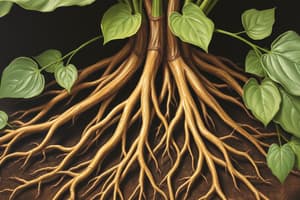Podcast
Questions and Answers
¿Cuál es el enfoque principal de la anatomía de plantas?
¿Cuál es el enfoque principal de la anatomía de plantas?
- La interacción entre plantas y su entorno
- El estudio de la clasificación de plantas
- La organización y función de células, tejidos y órganos de plantas (correct)
- El uso tradicional de plantas por parte de los humanos
¿Qué es la nomenclatura en botánica?
¿Qué es la nomenclatura en botánica?
- El estudio de las relaciones entre diferentes especies de plantas
- El estudio de la evolución de las plantas
- El conjunto de reglas para nombrar plantas (correct)
- La clasificación de plantas en grupos taxonómicos
¿Qué es el estudio de la comunidad de plantas en Ecología Botánica?
¿Qué es el estudio de la comunidad de plantas en Ecología Botánica?
- El estudio de la interacción entre plantas dentro de una comunidad (correct)
- El estudio de la interacción entre plantas y su entorno
- El estudio de la respuesta de las plantas a los estímulos ambientales
- El estudio de las poblaciones de plantas en su entorno
¿Qué es el estudio de la respuesta de las plantas a la luz en Fisiología Vegetal?
¿Qué es el estudio de la respuesta de las plantas a la luz en Fisiología Vegetal?
¿Qué es el objetivo principal de la etnobotánica?
¿Qué es el objetivo principal de la etnobotánica?
¿Qué proceso biológico es crucial para el crecimiento de las plantas?
¿Qué proceso biológico es crucial para el crecimiento de las plantas?
¿Qué es el estudio de la clasificación de plantas en Systematic Botany?
¿Qué es el estudio de la clasificación de plantas en Systematic Botany?
¿Qué es el estudio de la interacción entre plantas y su entorno en Ecología Botánica?
¿Qué es el estudio de la interacción entre plantas y su entorno en Ecología Botánica?
¿Qué es el estudio de la función de las hormonas en Fisiología Vegetal?
¿Qué es el estudio de la función de las hormonas en Fisiología Vegetal?
¿Qué es el estudio de la evolución de las plantas en Systematic Botany?
¿Qué es el estudio de la evolución de las plantas en Systematic Botany?
Study Notes
Plant Anatomy
- Study of the internal structure of plants
- Focuses on the organization and function of plant cells, tissues, and organs
- Includes:
- Cell structure and function
- Tissue types (e.g. parenchyma, collenchyma, sclerenchyma)
- Organ structure and function (e.g. roots, stems, leaves)
Systematic Botany
- Study of the classification, identification, and naming of plants
- Focuses on the relationships between different plant species
- Includes:
- Taxonomy: classification of plants into groups (e.g. kingdom, phylum, class, order, family, genus, species)
- Nomenclature: rules for naming plants
- Phylogeny: study of evolutionary relationships between plants
Ecological Botany
- Study of the interactions between plants and their environment
- Focuses on the role of plants in ecosystems
- Includes:
- Plant community ecology: study of plant interactions within communities
- Plant population ecology: study of plant populations in their environment
- Plant-environment interactions: study of how plants respond to and affect their environment
Ethnobotany
- Study of the traditional use of plants by humans
- Focuses on the cultural significance of plants in different societies
- Includes:
- Medicinal uses of plants
- Food uses of plants
- Ritual and ceremonial uses of plants
- Conservation of traditional plant knowledge
Plant Physiology
- Study of the functions and processes that occur within plants
- Focuses on the biological and biochemical processes that allow plants to grow and respond to their environment
- Includes:
- Photosynthesis: process of converting light energy into chemical energy
- Respiration: process of generating energy from glucose
- Hormone function: regulation of plant growth and development by hormones
- Responses to environmental stimuli: plant responses to light, temperature, water, and nutrients
Studying That Suits You
Use AI to generate personalized quizzes and flashcards to suit your learning preferences.
Description
Test your knowledge of plant anatomy, systematic botany, ecological botany, ethnobotany, and plant physiology. Learn about the internal structure, classification, and functions of plants, as well as their interactions with the environment and human societies.





